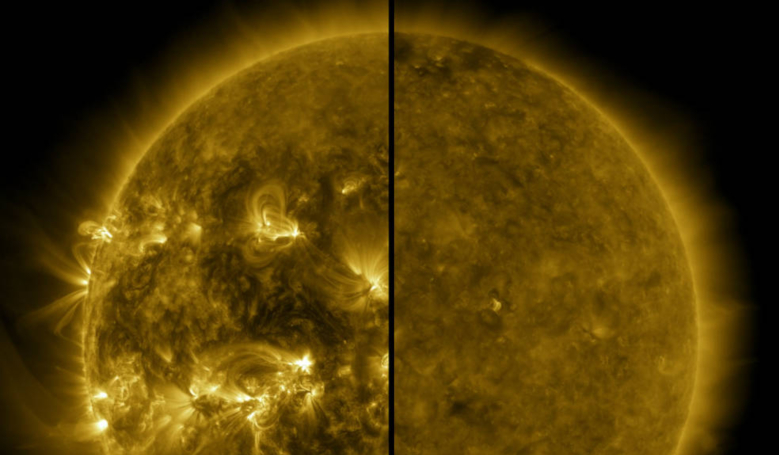Get ready for ramped up solar activity and more sunspots as the Sun’s relatively quiet period is now officially over announced NASA scientists yesterday and a new cycle, dubbed cycle 25, has begun.
One of the most basic ways scientists study how solar activity rises and falls over time, is with a pencil and piece of paper.
Armed with this simple low-tech solution, teams of collaborators around the world mark the position of sunspots at the same time each day for consistency, on a simple picture of the Sun.
Some 80 stations around the world contribute to this data and once recorded, the daily sunspot censuses are then sent for processing at the World Data Center for the Sunsport Index and Long-term Solar Observations at the Royal Observatory of Belgium in Brussels.
Scientists don't just rely on sunspot activity though. Other indicators also help determine when the Sun is reaching a low, such as an increase in cosmic rays in the solar system.
Normally, the Sun’s strong magnetic field provides a protective shield around all of the planets, that makes it difficult for highly energetic radiation to infiltrate. But when the Sun is at a solar minimum, it's ordered and relaxed magnetic field weakens at the poles allowing the cosmic rays to penetrate through.
Over the past few years, solar activity during the last cycle, cycle 24, has been relatively low, said experts from NASA and the National Oceanic and Atmospheric Administration (NOAA) during a media event on Tuesday. In December 2019 this lull in behaviour came to an end when statistics in January 2020 showed that sunspot numbers rose for the first time since cycle 24's maximum in April 2014.
These figures have only just been confirmed because our Sun is so variable and it can take months to declare the start of a new solar cycle, NASA said.
“As we emerge from solar minimum and approach Cycle 25’s maximum, it is important to remember solar activity never stops; it changes form as the pendulum swings,” said Lika Guhathakurta, solar scientist at the Heliophysics Division at NASA Headquarters in Washington.
This new cycle though is forecast to be about the same strength as the solar cycle that just ended, which was below-average, but not without risk.
“Just because it’s a below-average solar cycle, doesn’t mean there is no risk of extreme space weather,” says Doug Biesecker, panel co-chair and solar physicist at NOAA’s Space Weather Prediction Center (SWPC) in Boulder, Colorado.
“The Sun’s impact on our daily lives is real and is there. SWPC is staffed 24/7, 365 days a year because the Sun is always capable of giving us something to forecast.”
Understanding the Sun’s behavior is important not only to safeguard satellites and communications signals from violent solar outbursts, but also to help mitigate astronaut exposure to harmful radiation.
“There is no bad weather, just bad preparation,” said Jake Bleacher, chief scientist for NASA’s Human Exploration and Operations Mission Directorate at the agency’s Headquarters. “Space weather is what it is – our job is to prepare.”
Last month NASA selected five proposals for concept studies of missions to help improve understanding of the dynamics of the Sun.
These include, Solar-Terrestrial Observer for the Response of the Magnetosphere (STORM); HelioSwarm: The Nature of Turbulence in Space Plasmas; Multi-slit Solar Explorer (MUSE); Auroral Reconstruction CubeSwarm (ARCS) and Solaris: Revealing the Mysteries of the Sun’s Poles.
The proposals, which are funded by NASA’s Heliophysics Explorers’ programme, will receive $1.25 million to conduct a nine-month mission concept study and the agency will choose up to two proposals to go forward to launch.
“We constantly seek missions that use cutting edge technology and novel approaches to push the boundaries of science,” said Thomas Zurbuchen, associate administrator for NASA’s Science Mission Directorate in August.
“Each one of these proposals offers the chance to observe something we have never before seen or to provide unprecedented insights into key areas of research, all to further the exploration of the universe we live in.”
Meanwhile, scientists are currently working on predictive models so they can one day forecast space weather much like meteorologists forecast weather on Earth.
To aid in the process NOAA are launching a Space Weather Follow-On (SWFO) satellite designed to make direct, in-situ, measurements of the solar wind thermal plasma and magnetic field “up-stream” of the Earth.
This will help scientists to provide warnings about potential space weather events that could play havoc with the electrical power grid as well as navigation and timing systems like the Global Positioning System (GPS).
The satellite is due for launch in 2024, ahead of Solar Cycle 25’s predicted peak in July 2025.











